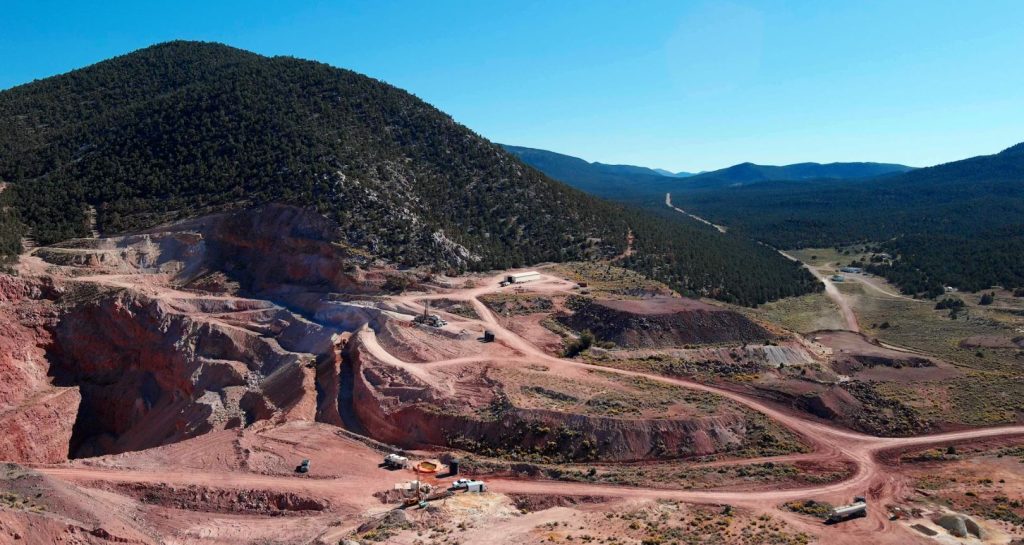Nevada King Gold reviews 2024 Atlanta Project, Nevada

Nevada King Gold Corp. [TSXV; NKG; OTCQX: NKGFF] reviewed accomplishments at its 100%-owned Atlanta gold mine project during 2024, including highlights and technical insights from its phase II drill program.
The company would also like to provide a look ahead toward 2025 and plans for its continuing phase III drill program. Drilling in 2024 clearly demonstrated resource growth potential in all directions while continuing to show consistent, high-grade, oxide material over thick intercepts at the 12,000-hectare (120 km2) Atlanta project, located in the prolific Battle Mountain trend 264 km northeast of Las Vegas, Nevada. Since mid-July, the company discovered three new gold mineralized zones.
2024 corporate highlights: The company made a significant new discovery at the South Quartzite Ridge target (SQRT), intercepting 6.28 g/t gold over 54.9 metres in intrusive rock found immediately beneath the quartzite cap. The SQRT is adjacent to and on trend with the Atlanta resource zone, measures 2,500 metres in strike and spans 500 metres wide, and is underlain by a large geophysical anomaly with a footprint that is significantly larger than the resource area. Phase III drilling at the target began earlier this month and it is the first time this target area has been drilled.
Geophysics were proven an effective tool for finding gold evidenced by the three discoveries made east, west and south of the Atlanta resource zone in the second half of 2024. The company intercepted 1.32 g/t gold over 22.9 metres in a clear geophysical anomaly at the East Ridge target (ERT). Geophysical survey results were also the impetus for the 150-metre step-out into the Wild West zone (WWZ), where the company intercepted 7.94 g/t gold over 18.3 metres within 4.67 g/t over 42.7 metres. At the SQRT, geophysics played prominently in the discovery and in identifying new targets for the phase III drill program.
Step-out drilling from the resource area shows clear expansion potential. Drilling at the North Extension target (NET) shows mineralization extending to the north of the resource area, while drilling west and downdip of the historical resource area in the WWZ reveals a high-grade depth extension of the deposit.
Nevada King completed its phase II drill program that included 84,284 metres from 450 holes from 2022 to 2024. In 2024 alone, the company drilled 75 reverse circulation (RC) holes and one core hole at Atlanta, accounting for over 17,007 metres.
Positive metallurgical test results were released. Phase I metallurgical test results showed strong recoveries using conventional processing methods for Nevada oxide deposits, including 86-92% for high-grade gold using mill processing, and 71-87% for heap leach processing hosted in silicified breccias and volcanics, respectively. Phase II test work is continuing and will be released in the first half of 2025.
The company raised a total of $21.6 million at a weighted average price of 34.5 cents per share. Founder and CEO Collin Kettell participated in both financings increasing his ownership position to 18% while management and insiders increased their total ownership position to 36%. Existing shareholders continued to show strong support and the company doubled its institutional shareholder base with significant new fund participation. The company will enter 2025 in a strong financial position and is fully financed to complete its phase III drill program.
Nevada King appointed John Sclodnick as president.
Road construction and modification to plan of operations: The Bureau of Land Management (BLM) approved the company’s modification to its plan of operations, allowing for commencement of phase III drilling. Road construction to gain access for drilling at the SQRT was completed ahead of schedule and below budget.
Phase III drilling has begun and is planned to cover 20,000 metres, with potential to increase to 30,000 metres based on success, with about half the drilling budget focused on follow-up discoveries, including at the SQRT, with the other half testing 12 regional targets identified by geophysical anomalies.
In 2024, the company drilled 17,007 metres between expansion and infill drilling, designed to improve the confidence of the resource model and to push the boundaries of the resource in areas of potential growth along strike and at depth. The most significant drill hole assays released in 2024 were: AT23NS-174 intersecting 6.90 g/t gold over 68.6 metres; AT23WS-44C intersecting 3.95 g/t gold over 106.7 metres; AT23NS-174A intersecting 4.90 g/t gold over 77.7 metres; AT23WS-23C.1 intersecting 4.51 g/t gold over 86.3 metres; AT24HG-41 intersecting 5.14 g/t gold over 68.6 metres; AT23WS-52 intersecting 2.29 g/t gold over 123.5 metres; AT23WS-62 intersecting 6.05 g/t gold over 41.2 metres and other encouraging assays.
Importantly, the fifth-best hole the company drilled this year, which included a subset of 6.28 g/t gold over 54.9 metres, was in the newly discovered SQRT area, showing potential for more bonanza high grade in oxide material, along trend to the south, which is currently a focus of phase III drilling.
Nevada King has now begun its phase III drill program, expected to cover at least 20,000 metres over 80 drill holes, with potential to increase this amount to 30,000 metres contingent on success.
Gold mineralization is already known to extend six km across the property and phase III will test 12 other targets to see if it occurs in other areas of the property. The untested targets include Bounty, Corral, Crossroads, Jumbo, Lone Ranger, Mustang, Northeast, Outlaw, Rangefront, Silver Park East, Silver Park West and Western Knolls. Overall, the phase III program has the potential to turn 2025 into a transformative year for the company and its Atlanta gold mine project as it looks to grow mineralization in the SQRT and finds new satellite deposits.
The Atlanta mine is a historical gold-silver producer with an NI 43-101 compliant pit-constrained resource of 460,000 ounces gold in the measured and indicated category (11.0 million tonnes at 1.3 g/t) plus an inferred resource of 142,000 ounces gold (5.3 million tonnes at 0.83 g/t).
